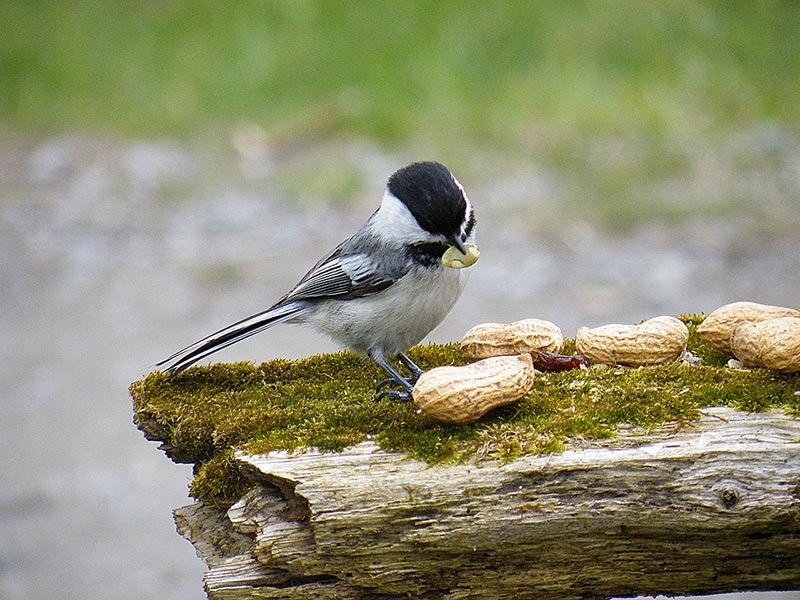What Do Chickadees Eat? 6 Common Foods
Last Updated on

Chickadees are popular songbirds that birdwatchers and others love to attract to their yards because of their pretty looks and beautiful song. Chickadees are found throughout the U.S. and are also found in various countries across the Northern Hemisphere where they are called tits rather than chickadees. They tend to be chirpy, intelligent, and friendly little birds, too, which also adds to their popularity.
If you’re looking to attract chickadees to your garden, there are certain foods that you can put out to help attract them. Read on for 6 common foods chickadees eat, as well as some other tips to help attract them to your garden.

The 6 Common Foods That Chickadees Eat Are:
1. Seeds

Seeds are a garden chickadee’s favorite snack. They enjoy a good variety of seeds, including safflower and thistle, but their absolute favorite tends to be sunflower seeds. Such is their love for sunflower seeds that they will eat any type, and this is the preferred snack for those that are trying to train their local chickadees to eat from the palm of their hands. As well as buying sunflower seeds, you can plant your own sunflowers and leave the seeds for the birds to consume.
2. Insects

Chickadees are omnivores, which means that they eat every food type. They get their meat from insects in the wild and will forage for small insects from the branches and bark of trees, as well as the floor. You don’t have to try and herd ants or round up beetles to feed chickadees, but you can put mealworms on your feeder. These will prove especially popular in winter, and you can scatter them on the floor or, if your floor isn’t that safe a space, put them on a platform feeder.
3. Nuts

Chickadees are a type of songbird and songbirds have a unique toe layout. This enables them to hang on to branches while foraging, but it also means that they are well equipped to eat nuts—and especially enjoy peanuts. Try giving peanuts to them and watch as the little birds hold them between their feet and peck with their beaks to try and get to the nutty goodness inside.
4. Fruit

This little bird also enjoys a good fruit snack, and while they can gather small berries from bushes easily in summer, it can prove more of a challenge to locate them during the winter months. Put out blueberries or small pieces of grapes. Alternatively, you could grow blueberry bushes and let your chickadee visitors help themselves, but you will have to grow plenty if you want to ensure you have some left for yourself.
5. Suet

Suet cakes, or suet balls, are made up of fat and typically include nuts and seeds. They are a good source of protein, as well as vitamins and minerals, and are very popular with some types of birds. They are a good feeding option for chickadees, who can easily hang off the cage that holds the suet and peck at the protein-filled treat inside. Rather than buying commercial suet balls, you can make your own at home.
6. Peanut Butter

Peanut butter might be a more convenient option than peanuts. At the very least, they will not blow off a platform feeder. Ensure you buy unsweetened, unsalted peanut butter. You can always add peanut butter to your homemade suet balls to create a really tasty treat for your garden visitors.

Other Tips to Attract Chickadees
Chickadees are intelligent, pretty, and have a pleasant song. They can also be encouraged to feed from your hand, which makes them a popular addition to the garden or yard. Although there is no guarantee of attracting this pretty little bird, there are some ways that you can try to encourage them and enjoy at least a modest degree of luck. For a start, offer them their favorite foods, as listed above, and consider the following tips to further help your plight.
- Grow Appropriate Plants – We already mentioned above that chickadees love seeds and berries. But as well as growing your sunflowers and blueberry bushes and letting the birds have free reign over them, you can also plant other trees and shrubs to offer foraging sites.
- Add Bird Baths – Chickadees will visit birdbaths to clean and drink from. The water needs to be shallow, and if the bath is too deep, you should find ways to ensure that the birds have somewhere to perch while in the water. Because chickadees do not migrate for winter, providing a heater birdbath can prove a very effective way of attracting them to your garden during the colder months.
- Offer Trees – Plant conifers. These give shade and they present foraging opportunities for your chickadee guests. You can also smear soft suet or peanut butter on the trunk and branches to encourage foraging and they may be used for nesting and roosting.
- Erect Birdhouses – Birdhouses are another good addition to your garden. The houses should be at least 5 feet off the ground, as high as 15 feet, and you should provide nesting materials like string and wood shavings to further encourage the songbird to nest where you can see them.

What States Have Chickadees?
The species is found in all states, including Alaska. There are seven different species that you might see, although some, like the Gray-headed Chickadee, are very rare and difficult to spot, and most have a specific range where you will see them. The species are Black-capped, Mountain, Boreal, Carolina, Gray-headed, Mexican, and Chestnut-backed Chickadee. Although there are some differences, they all eat and enjoy the same foods.
Do Chickadees Recognize Humans?
Not only is it believed that chickadees recognize humans, but it is possible to attract them to take food from your hand as well as visit your garden for their food and water needs. In fact, some studies show that chickadees can “understand” what humans are saying. At least, they seem able to understand the emotion behind what people are saying, and they can do the same with other types of animals. With that said, it is unlikely that chickadees can differentiate one human from another.

Final Thoughts
Chickadees are one of the most common types of bird in the U.S. and there are seven species found across all states. They can be attracted to a garden with food including nuts and seeds, and with some gentle coaxing and a little training, it is even possible to have them take food from your hand.
Featured Image Credit By: struza, Pixabay
About the Author Robert Sparks
Robert’s obsession with all things optical started early in life, when his optician father would bring home prototypes for Robert to play with. Nowadays, Robert is dedicated to helping others find the right optics for their needs. His hobbies include astronomy, astrophysics, and model building. Originally from Newark, NJ, he resides in Santa Fe, New Mexico, where the nighttime skies are filled with glittering stars.
Related Articles:
10 Types of Hummingbirds in Arkansas (With Pictures)
8 Types of Hummingbirds in Nebraska (With Pictures)
5 Types of Hummingbirds in Idaho (With Pictures)
3 Types of Hummingbirds in Mississippi (With Pictures)
8 Types of Hummingbirds in Kansas (With Pictures)
5 Types of Hummingbirds in West Virginia (With Pictures)
5 Types of Hummingbirds in Ohio (With Pictures)
Where Do Nuthatches Nest? Nuthatch Nesting Habits Explained
